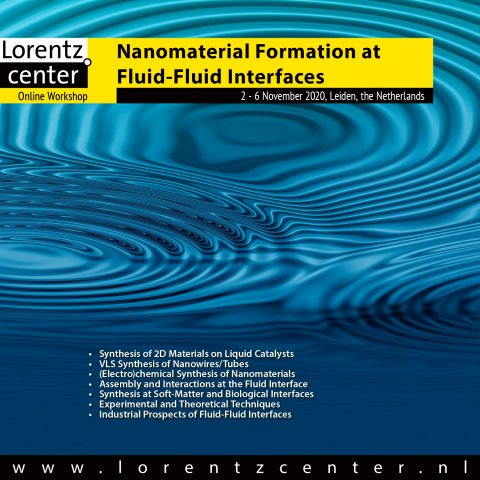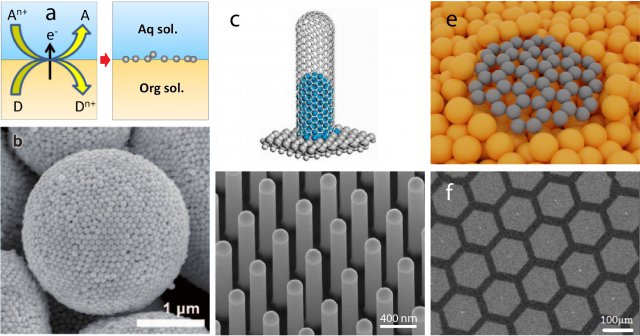Online Lorentz Workshop: Nanomaterial Formation at Fluid-Fluid Interfaces

Scientific organizers: Mehdi Saedi1, Irene Groot1, Maciej Jankowski2
a.saedi@lic.leidenuniv.nl, i.m.n.groot@lic.leidenuniv.nl, maciej.jankowski@esrf.fr
1. Leiden institute of Chemistry, Leiden University, The Netherlands
2. Alternative Energies Commission (CEA), Grenoble, France
Every major leap in the history of human civilization has been associated with mastering the utilization of a particular class of materials. Nowadays, nanomaterials are considered to be one of the primary candidates for enabling the next technological revolution in human history. However, utilization of nanomaterials’ unique properties in the publicly available technologies, faces the formidable challenge of devising efficient and reliable synthesis and assembly methods for them. After years of research on nanomaterials, we have reached a critical point where nanomaterials should make a decisive leap into real-life applications and everyday devices.
Among the myriad of examined fabrication methods, examples such as the formation of 2D materials on liquid metal catalysts (LMCats)* [1,2], synthesis of 1D materials (e.g. nanowires and nanotubes) via a vapor-liquid-solid (VLS) mechanism [3], and electro/chemical formation and assembly of 0D materials (e.g. nanoparticles, nanocapsules) at gas-liquid or liquid-liquid interfaces [4,5], are considered to be among the most successful, efficient, and versatile ones (see Fig. 1). The curious point is that all these methods involve a fluid-fluid (gas-liquid or liquid-liquid) interface (with disordered and mobile atomic nature) for the synthesis and assembly of nanomaterials with ordered internal structure and external arrangement. This common feature seems to be the key ingredient in devising an efficient fabrication method for virtually all classes of nanomaterials.
Different classes of nanomaterials however, have been historically developed by separate scientific and technological sub-communities. As a result, their techniques and theories have been evolved mostly independently, and they have been discussed in the literature as separate topics. The Lorentz Center and its interactive workshop format is an excellent platform to gather experts from different scientific and technological sub-communities together, where they can share their experiences and visions from their specific vantage points on this important common ground.
Figure 1. Example of nanomaterials formation involving fluid-fluid interfaces: a) Schematic of electrochemical formation of metal nanoparticles at a liquid-liquid interface [4], b) SEM image of nanocapsules, formed by self-assembly of gold nanoparticles around emulsion drops [6], c) Atomic model of carbon nanotube formation using the VLS mechanism with the liquid catalyst particle at its bottom [3], d) SEM image of indium phosphide nanowires synthesized using the VLS mechanism with the catalyst particles at their top [7], e) Atomic model of graphene flake formation on LMCats [2], f) In situ optical microscopy image of self-assembled hexagonal graphene flakes synthesized on LMCat (molten copper) via the chemical vapor deposition (CVD) process [2]
Figure 1. Example of nanomaterials formation involving fluid-fluid interfaces: a) Schematic of electrochemical formation of metal nanoparticles at a liquid-liquid interface [4], b) SEM image of nanocapsules, formed by self-assembly of gold nanoparticles around emulsion drops [6], c) Atomic model of carbon nanotube formation using the VLS mechanism with the liquid catalyst particle at its bottom [3], d) SEM image of indium phosphide nanowires synthesized using the VLS mechanism with the catalyst particles at their top [7], e) Atomic model of graphene flake formation on LMCats [2], f) In situ optical microscopy image of self-assembled hexagonal graphene flakes synthesized on LMCat (molten copper) via the chemical vapor deposition (CVD) process [2].
The workshop strives to explore a diverse range of topics including:
- Synthesis of 2D materials on liquid metal catalysts
- Synthesis of nanowires/tubes via vapor-liquid-solid mechanisms
- (Electro)chemical synthesis of nanoparticles at liquid-liquid interfaces
- Assembly and interactions of nanomaterials at fluid-fluid interfaces
- Molecular formation at fluid-fluid interfaces in soft-matter and biological systems
- Experimental and theoretical techniques for nanomaterials at fluid-fluid interfaces
- Industrial prospects of fluid-fluid interfaces for nanomaterials synthesis
Deo Volente, the workshop will be conducted on 2–6 November 2020 by Lorentz Center * (Science Faculty, Leiden University, The Netherlands) with 10 invited speakers and up to 55 expected participants. Due to the uncertain situation with the COVID-19 pandemic, we are holding the workshop as online.
In addition to excellent lectures from world leading experts, the program heavily relies on group discussion sessions with topics in line with the general aims and deliverables of the workshop, including:
- Determining the unique properties and potentials of fluid-fluid interfaces for nanomaterials formation (synthesis and assembly) and comparing their (dis)advantages to other nanomaterials formation methods and mediums.
- Pinpointing the major unknowns about the formation of nanomaterials at fluid-fluid interfaces, and coming up with new theoretical and experimental methods to study and understand these phenomena.
- Determining the main obstacles against the incorporation of nanomaterials in everyday devices and at industrial scale, and evaluating the potentials of fluid-fluid interfaces in tackling the industrialization of nanomaterials.
Each participant will join a topical discussion group of his/her interest inspired by the lectures of that day. A senior researcher will chair each topical discussion group. Meanwhile a junior representative researcher will gather the minutes of his/her group. In the plenary meeting of the last day, the collective report and conclusions of the workshop will be presented by the organizers. All participants will also be encouraged to bring relevant posters or banners to the workshop, to be presented in (a) dedicated poster session(s).
* See our LC workshop webpage at: https://www.lorentzcenter.nl/nanomaterial-formation-at-fluid-fluid-interfaces.html
The registration is closed now, but you may still join the online event free of charge by contacting the scientific organizers
- J. Liu, L. Fu, Controllable Growth of Graphene on Liquid Surfaces. Adv. Mater. 31, 1800690 (2019).
- M. Saedi, J.M. de Voogd, A. Sjardin, A. Manikas, C. Galiotis, M. Jankowski, G. Renaud, F. La Porta, O. Konovalov, G.J.C. van Baarle, I.M.N. Groot, Development of a reactor for the in situ monitoring of 2D materials growth on liquid metal catalysts, using synchrotron X-ray scattering, Raman spectroscopy, and optical microscopy, Rev. Sci. Instrum. 91, 013907 (2020).
- T. Maruyama, Current status of single-walled carbon nanotube synthesis from metal catalysts by chemical vapor deposition. Mater. Express, 8, 1–2 (2018).
- R.A.W. Dryfe, A. Uehara, S.G. Booth, Metal Deposition at the Liquid–Liquid Interface, Chem. Rec. 14, 1013–1023 (2014).
- S. Shi, T.P. Russell, Nanoparticle Assembly at Liquid–Liquid Interfaces: From the Nanoscale to Mesoscale, Adv. Mater. 30, 1800714 (2018).
- D. Liu, F. Zhou, C. Li, T. Zhang, H. Zhang, W. Cai, and Y. Li, Black Gold: Plasmonic Colloidosomes with Broadband Absorption Self-Assembled from Monodispersed Gold Nanospheres by Using a Reverse Emulsion System, Angew. Chem. Int. Ed. 54, 9596–9600 (2015).
- J. Wallentin, N. Anttu, D. Asoli, et al. InP Nanowire Array Solar Cells Achieving 13.8% Efficiency by Exceeding the Ray Optics Limit, Science 339, 1057–1060 (2013).
Monday 2 Nov 2020
09:00–09:30 CET Welcome by Lorentz center and organizers,
09:30–10:30 CET Lecture: Emergence of liquid metals in nanotechnology, Kourosh Kalantar-Zadeh, University of New South Wales, Australia
13:00–14:00 CET Lecture: Nanoparticle synthesis and assembly at electrolyte/electrolyte interfaces, Robert A. W. Dryfe, University of Manchester, UK
18:00–19:00 CET Plenary group discussion: Potentials of fluid-fluid interfaces for nanomaterials formation (synthesis and assembly) in comparison to other methods
21:00–22:00 CET Lecture: In situ studies of graphene growth on liquid copper, LMCat Consortium
Tuesday 3 Nov 2020
09:00–10:00 CET Lecture: Synthesis of carbon nanotubes via vapor-liquid-solid mechanism, Takahiro Maruyama, Meijo University, Japan
13:00–14:00 CET Plenary group discussion: Major unknowns about the nanomaterial formation at fluid-fluid interfaces. Ideas for new theoretical and experimental methods to study and understand them
15:00–16:00 CET Lecture: Theoretical studies of fluid-fluid interfaces, Serafim Kalliadasis, Imperial College London, UK
21:00–22:00 CET Lecture: Molecular formation at fluid interfaces in (bio)soft-matter systems, Lorenzo Di Michele, Imperial College London, UK
Wednesday 4 Nov. 2020
09:00–10:00 CET Lecture: Probing the structure at fluid interfaces by X-ray diffraction, Bridget Murphy, Kiel University, Germany
13:00–14:00 CET Lecture: Industrial scale graphene production on liquid metal, Dominika Gnatek, Advanced Graphene products, Poland
18:00–19:00 CET Plenary group discussion: Prospects of fluid-fluid interfaces for industrial production of nanomaterials and their incorporation in every day applications/devices
21:00–22:00 CET Lecture: Vapor-Liquid-Solid Growth as a Route to Hyper-scalable Nanoelectronic Device Manufacturing
Michael A. Filler, Georgia Institute of Technology, US
Thursday 5 Nov. 2020
09:00–10:00 CET Lecture: Nanoparticle assembly and interactions at fluid interface, Thomas P. Russell, University of Massachusetts Amherst, US
13:00–14:00 CET Poster presentations and individual discussions
18:00–19:00 CET Lecture: Spectroscopy and simulations at fluid-fluid interfaces, Heather C. Allen, The Ohio State University, US
21:00–22:00 CET Closing plenary group discussion and workshop conclusion
Friday 6 Nov. 2020 Optional individual meetings

